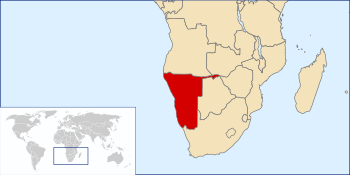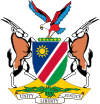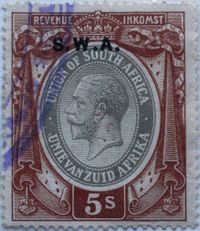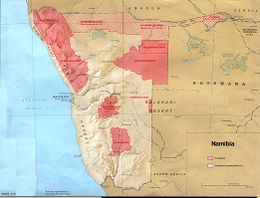جنوب غرب أفريقيا
جنوب غرب أفريقيا Suidwes-Afrika Zuidwest-Afrika Südwestafrika | |||||||||
|---|---|---|---|---|---|---|---|---|---|
| 1915–1990 | |||||||||
 موقع جنوب غرب أفريقيا | |||||||||
| المكانة | انتداب عصبة الأمم | ||||||||
| العاصمة | ويندهوك | ||||||||
| اللغات الشائعة | الإنگليزية، أفريكانز، خوي خوي، الهولندية (1915–1983) والألمانية (1884–1990) | ||||||||
| التاريخ | |||||||||
• تأسست | 1915 | ||||||||
| 28 يونيو 1919 | |||||||||
• الاستقلال | 21 مارس 1990 | ||||||||
| Currency | جنيه جنوب غرب أفريقيا (1920–61) راند جنوب أفريقيا (1961–90) | ||||||||
| |||||||||
جزء من سلسلة عن |
|---|
| تاريخ ناميبيا |
 |
جنوب غرب أفريقيا (إنگليزية: South-West Africa؛ أفريكانز: Suidwes-Afrika؛ هولندية: Zuidwest-Afrika؛ ألمانية: Südwestafrika) كان اسم ما هو الآن ناميبيا حين كانت تُحكم من قِبل الامبراطورية الألمانية ولاحقاً جنوب أفريقيا.
مستعمرة ألمانية
كمستعمرة ألمانية من 1884، كانت تُعرف بإسم جنوب غرب أفريقيا الألماني (Deutsch-Südwestafrika). وقد واجهت ألمانيا مصاعب في ادارة تلك الأرض، بسبب مقاومة الأهالي، وخصوصاً بقيادة الزعيم الثوري جاكوب مورنگا. الميناء الرئيسي وخليج والڤيس وجزيرة طيور البطريق ضمتهم بريطانيا في 1878، ليصبحا جزءاً من مستعمرة الكاپ في 1884.[1] وإثر خلق اتحاد جنوب أفريقيا في 1910، أصبح خليج والڤيس جزءاً من مقاطعة الكاپ.[2]
وكجزء من معاهدة هليگولاند-زنزبار في 1890، أضيف رواق أرضي مأخوذ من الحد الشمالي لـ بتشوانالاند، يمتد بعيداً حتى نهر زمبيزي، إلى المستعمرة. وقد سُمِّي قطاع كاپريڤي (Caprivizipfel) على اسم المستشار الألماني ليو فون كاپريڤي.[3]
حكم جنوب أفريقيا
في 1915، أثناء حملة جنوب غرب أفريقيا في الحرب العالمية الأولى، استولت جنوب أفريقيا على المستعمرة الألمانية. وبعد الحرب، أُعلِنت أرض انتداب من المرتبة ج من عصبة الأمم بموجب معاهدة ڤرساي، يكون فيه اتحاد جنوب أفريقيا مسئولاً عن ادارة جنوب غرب أفريقيا. ومنذ 1922، تم ضم خليج والڤيس، الذي، بموجب قانون شئون جنوب غرب أفريقيا، ليُحكم كجزء من أرض الانتداب.[4] وقد ظل جنوب غرب أفريقيا انتداباً لعصبة الأمم حتى الحرب العالمية الثانية.[بحاجة لمصدر]
الانتداب كان يُفترض أن يصبح أرض وصاية الأمم المتحدة حين انتقلت انتدابات عصبة الأمم إلى الأمم المتحدة بعد الحرب العالمية الثانية. عارض رئيس الوزراء، يان سموتس، أن يصبح جنوب غرب أفريقيا تحت سيطرة الأمم المتحدة ورفض السماح بانتقال الأرض إلى الاستقلال، وبدلاً من ذلك سعى لجعلها المقاطعة الخامسة في جنوب أفريقيا في 1946.[5]
Although this never occurred, in 1949, the South-West Africa Affairs Act was amended to give representation in the برلمان جنوب أفريقيا to whites in South-West Africa, which gave them six seats in the House of Assembly and four in the Senate.[6]
This was to the advantage of the National Party, which enjoyed strong support from the predominantly Afrikaners and ethnic German white population in the territory.[7] Between 1950 and 1977, all of South-West Africa's parliamentary seats were held by the Nationalists.[8]
An additional consequence of this was the extension of apartheid laws to the territory.[9] This gave rise to several rulings at the International Court of Justice, which in 1950 ruled that South Africa was not obliged to convert South-West Africa into a UN trust territory, but was still bound by the League of Nations Mandate with the United Nations General Assembly assuming the supervisory role. The ICJ also clarified that the General Assembly was empowered to receive petitions from the inhabitants of South-West Africa and to call for reports from the mandatory nation, South Africa.[10] The General Assembly constituted the Committee on South-West Africa to perform the supervisory functions.[11]
In another Advisory Opinion issued in 1955, the Court further ruled that the General Assembly was not required to follow League of Nations voting procedures in determining questions concerning South-West Africa.[12] In 1956, the Court further ruled that the Committee had the power to grant hearings to petitioners from the mandated territory.[13] In 1960, Ethiopia and Liberia filed a case in the International Court of Justice against South Africa alleging that South Africa had not fulfilled its mandatory duties. This case did not succeed, with the Court ruling in 1966 that they were not the proper parties to bring the case.[14][15]
إنهاء انتداب الأمم المتحدة
There was a protracted struggle between South Africa and forces fighting for independence, particularly after the formation of the South West Africa People's Organisation (سواپو SWAPO) في 1960.
In 1966, the General Assembly passed resolution 2145 (XXI) which declared the Mandate terminated and that the Republic of South Africa had no further right to administer South-West Africa.[16] In 1971, acting on a request for an Advisory Opinion from the United Nations Security Council, the ICJ ruled that the continued presence of South Africa in Namibia was illegal and that South Africa was under an obligation to withdraw from Namibia immediately. It also ruled that all member states of the United Nations were under an obligation not to recognise as valid any act performed by South Africa on behalf of Namibia.[17]
South-West Africa became known as Namibia by the UN when the General Assembly changed the territory's name by Resolution 2372 (XXII) of 12 June 1968.[18] SWAPO was recognised as representative of the Namibian people and gained UN observer status[19] when the territory of South-West Africa was already removed from the list of Non-Self-Governing Territories.
In 1977, South Africa transferred control of Walvis Bay back to the Cape Province, thereby making it an exclave.[20]
The territory became the independent Republic of Namibia on 21 March 1990, although Walvis Bay and the Penguin Islands were only incorporated into Namibia in 1994.[21]
البانتوستانات
أسست سلطات جنوب أفريقيا عشر بانتوستانات في جنوب غرب أفريقيا في أواخر ع1960 ومطلع ع1970 حسب توصيات مفوضية أودندال، ثلاثة منهم حصلوا على حكم ذاتي.[22] تلك البانتوستانات حل محلها حكومات منفصلة حسب الأعراق في 1980.
البانتوستانات كانت:
- باسترلاند
- بوشمانلاند
- دامارالاند
- شرق كاپريڤي (حكم ذاتي 1976)
- هريرولاند (حكم ذاتي 1970)
- كاوكولاند
- كاڤانگولاند (حكم ذاتي 1973)
- نامالاند
- أوڤامبولاند
- تسوانالاند
انظر أيضاً
- List of colonial heads of Namibia (South-West Africa)
- تاريخ ناميبيا
- South West African People's Organisation (SWAPO)
- South-West African Territorial Force (SWATF)
- South West African Police (SWAPOL)
- Koevoet
الهامش
- ^ Succession of States and Namibian territories, Y. Makonnen in Recueil Des Cours, 1986: Collected Courses of the Hague Academy of International Law, Academie de Droit International de la Haye, Martinus Nijhoff Publishers, 1987, page 213
- ^ Debates of Parliament, Hansard, Volume 9, Issues 19-21, Government Printer, 1993, page 10179
- ^ Caprivi Strip | Namibia. Namibian.org. Retrieved on 2012-12-18.
- ^ Walvis Bay: exclave no more, Ieuan Griffiths, Geography, Vol. 79, No. 4 (October 1994), page 354
- ^ The South-West Africa/Namibia Dispute: Documents and Scholarly Writings on the Controversy Between South Africa and the United Nations, John Dugard, University of California Press, 1973, page 124
- ^ Official Documents of the 4th Session of the United Nations General Assembly, United Nations, 1949, page 11
- ^ Afrikaner Politics in South Africa, 1934-1948, Newell M. Stultz, University of California Press, 1974, page 161
- ^ Mediating Conflict: Decision-making and Western Intervention in Namibia, Vivienne Jabri, Manchester University Press, 1990, page 46
- ^ Witness from the frontline: aggression and resistance in Southern Africa, Ben Turok Institute for African Alternatives, 1990, page 86
- ^ International Status of South-West Africa – Advisory Opinion at the Wayback Machine (archived أكتوبر 2, 2006)
- ^ List of United Nations Organisations and Resolutions concerning Namibia
- ^ Voting Procedure on Questions Relating to Reports and Petitions Concerning the Territory of South-West Africa – Advisory Opinion at the Wayback Machine (archived أكتوبر 2, 2006)
- ^ Admissibility of Hearings of Petitioners by the Committee on South-West Africa – Advisory Opinion at the Wayback Machine (archived أكتوبر 2, 2006)
- ^ South-West Africa Cases (Preliminary Objections) Ethiopia v. South Africa and Liberia v. South Africa at the Wayback Machine (archived أكتوبر 2, 2006)
- ^ South-West Africa Cases (Second Phase) Ethiopia v. South Africa and Liberia v. South Africa at the Wayback Machine (archived أكتوبر 2, 2006)
- ^ UN General Assembly, res n° 2154 (XXI), 17 November 1966. Available at http://www.un.org/documents/ga/res/21/ares21.htm [recovered october 1, 2015]
- ^ Legal Consequences for States of the Continued Presence of South Africa in Namibia (South-West Africa) notwithstanding Security Council Resolution 276 (1970) – Advisory Opinion
- ^ Legal Repertory of Practice of United Nations Organs
- ^ UNGA Resolution A/RES/31/152 Observer status for the South West Africa People's Organisation
- ^ The Green and the dry wood: The Roman Catholic Church (Vicariate of Windhoek) and the Namibian socio-political situation, 1971-1981, Oblates of Mary Immaculate, 1983, page 6
- ^ Treaty between the Government of the Republic of South Africa and the Government of the Republic of Namibia with respect to Walvis Bay and the off-shore Islands, 28 February 1994
- ^ World Statesman
- Pages using infobox country with unknown parameters
- Pages using infobox country or infobox former country with the flag caption or type parameters
- Portal-inline template with redlinked portals
- Pages with empty portal template
- Articles containing إنگليزية-language text
- Pages using Lang-xx templates
- Articles containing أفريكانز-language text
- Articles containing هولندية-language text
- Articles containing ألمانية-language text
- Articles with unsourced statements from January 2013
- تاريخ ناميبيا
- كيانات سياسية سابقة في الحرب الباردة
- بلدان سابقة في أفريقيا
- انتدابات عصبة الأمم
- علاقات جنوب أفريقيا-ناميبيا
- ناميبيا وكومنولث الأمم
- الأپارتهايد في جنوب غرب أفريقيا
- دول وأراضي تأسست في 1915
- دول وأراضي انحلت في 1990
- جنوب غرب أفريقيا
- تأسيسات 1915 في جنوب غرب أفريقيا
- انحلالات 1990 في جنوب غرب أفريقيا





